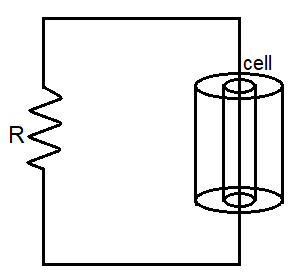
Model a torch battery of length l to be made up of a thin cylindrical bar of radius ‘a’ and a concentric thin cylindrical shell of radius ‘b’ filled in between with an electrolyte of resistivity \[\rho \] (see figure). If the battery is connected to the resistance of value R, the maximum joule heating in R will take place for:
A. \[R = \dfrac{\rho }{{2\pi l}}\left( {\dfrac{b}{a}} \right)\]
B. \[R = \dfrac{{2\rho }}{{\pi l}}\ln \left( {\dfrac{b}{a}} \right)\]
C. \[R = \dfrac{\rho }{{\pi l}}\ln \left( {\dfrac{b}{a}} \right)\]
D. \[R = \dfrac{\rho }{{2\pi l}}\ln \left( {\dfrac{b}{a}} \right)\]
Answer
218.7k+ views
Hint: Resistance in a circuit is something that opposes the flow of current in the circuit. Resistance is represented by a Greek letter called Omega \[\left( \Omega \right)\].
Formula Used:
\[dR = \rho \dfrac{{dr}}{{2\pi lr}}\]
where $R$ is the resistance, $l$ is the length of the cylinder, $r$ is the radius of the cylinder and \[\rho \] is the resistivity of the cylinder.
Complete step by step solution:
We know that the torch battery has a length l with a thin cylindrical bar of radius ‘a’ and a concentric thin cylindrical shell of radius ‘b’ filled in between with an electrolyte of resistivity \[\rho \], so we can model it as,

Image: Circuit diagram of a battery and resistance.
We know that the radius of the outer cylinder bar is $b$ and that of the inner cylinder bar is $a$, so using the resistance formula of resistivity and integrating it, we can find the resistance for the maximum joule heating as,
\[dR = \rho \dfrac{{dr}}{{2\pi lr}} \\
\Rightarrow \int {dR} = \dfrac{\rho }{{2\pi l}}\int_a^b {\dfrac{{dr}}{r}} \\
\Rightarrow R = \dfrac{\rho }{{2\pi l}}\left[ {\ln \left( r \right)} \right]_a^b \\
\therefore R = \dfrac{\rho }{{2\pi l}}\ln \left( {\dfrac{b}{a}} \right) \\ \]
So, option D, \[R = \dfrac{\rho }{{2\pi l}}\ln \left( {\dfrac{b}{a}} \right)\] is the required solution.
Note: As we already have the length and the resistivity of the cylinder, those factors will not change and remain constant, and we know that the thin cylinder bar and cylinder shell has a radius of ‘b’ and ‘a’ respectively, so the resistance will also be created only between that, so we will integrate the radius to find the resistance between the two cylinders.
Formula Used:
\[dR = \rho \dfrac{{dr}}{{2\pi lr}}\]
where $R$ is the resistance, $l$ is the length of the cylinder, $r$ is the radius of the cylinder and \[\rho \] is the resistivity of the cylinder.
Complete step by step solution:
We know that the torch battery has a length l with a thin cylindrical bar of radius ‘a’ and a concentric thin cylindrical shell of radius ‘b’ filled in between with an electrolyte of resistivity \[\rho \], so we can model it as,

Image: Circuit diagram of a battery and resistance.
We know that the radius of the outer cylinder bar is $b$ and that of the inner cylinder bar is $a$, so using the resistance formula of resistivity and integrating it, we can find the resistance for the maximum joule heating as,
\[dR = \rho \dfrac{{dr}}{{2\pi lr}} \\
\Rightarrow \int {dR} = \dfrac{\rho }{{2\pi l}}\int_a^b {\dfrac{{dr}}{r}} \\
\Rightarrow R = \dfrac{\rho }{{2\pi l}}\left[ {\ln \left( r \right)} \right]_a^b \\
\therefore R = \dfrac{\rho }{{2\pi l}}\ln \left( {\dfrac{b}{a}} \right) \\ \]
So, option D, \[R = \dfrac{\rho }{{2\pi l}}\ln \left( {\dfrac{b}{a}} \right)\] is the required solution.
Note: As we already have the length and the resistivity of the cylinder, those factors will not change and remain constant, and we know that the thin cylinder bar and cylinder shell has a radius of ‘b’ and ‘a’ respectively, so the resistance will also be created only between that, so we will integrate the radius to find the resistance between the two cylinders.
Recently Updated Pages
A square frame of side 10 cm and a long straight wire class 12 physics JEE_Main

The work done in slowly moving an electron of charge class 12 physics JEE_Main

Two identical charged spheres suspended from a common class 12 physics JEE_Main

According to Bohrs theory the timeaveraged magnetic class 12 physics JEE_Main

ill in the blanks Pure tungsten has A Low resistivity class 12 physics JEE_Main

The value of the resistor RS needed in the DC voltage class 12 physics JEE_Main

Trending doubts
JEE Main 2026: Application Form Open, Exam Dates, Syllabus, Eligibility & Question Papers

Derivation of Equation of Trajectory Explained for Students

Hybridisation in Chemistry – Concept, Types & Applications

Understanding the Angle of Deviation in a Prism

Understanding Collisions: Types and Examples for Students

Understanding Atomic Structure for Beginners

Other Pages
JEE Advanced Marks vs Ranks 2025: Understanding Category-wise Qualifying Marks and Previous Year Cut-offs

How to Convert a Galvanometer into an Ammeter or Voltmeter

Understanding Centrifugal Force in Physics

JEE Main Marking Scheme 2026- Paper-Wise Marks Distribution and Negative Marking Details

Degree of Dissociation: Meaning, Formula, Calculation & Uses

Understanding Electromagnetic Waves and Their Importance




